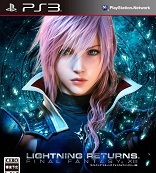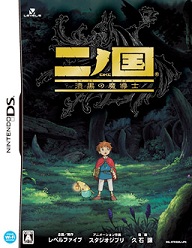Mario & Luigi: Partners in Time
Nintendo DS
Reviewed: 12/27/2005
 |
Planet Shroob, circa… a really, really long time ago. On this planet, something lived there. Something…creepy. Something…really, really creepy. No, seriously, creepier than a dog balancing on a severed human arm by its mouth. Well, okay. They’re not really that creepy. But they are purple. And as we all know, purple is the color of DOOM. Said doom is what is spelled when these creepy somethings decide that they’re too creepy even for themselves, and want to expand upon their creepiness. Where better for a race of creepy evil purple mushroom people to expand their creepiness than… Mushroom Kingdom?
Mario and Luigi: Partners in Time begins just like any decent game should. At the beginning. No, really. Back when the pair of plumbers were no more than toddlers. On a visit to Mushroom Castle to play with the princess, disaster strikes in the form of another familiar face. Bowser! The young princess is just about to be kidnapped, when suddenly–you guessed it–something very, very creepy appears. Fast forward to the present. Mushroom Kingdom’s brand new time machine is expected to return any minute. The young toddlers of yesteryear have grown up to be the legendary duo, the Mario Brothers. A flash of light, and suddenly the machine returns, in ruins, its passengers, the Princess Peach and her entourage, nowhere to be found. Instead, a horrible, slavering monster. After this monster is defeated, it is discovered that time portals are beginning to appear in the castle. Time portals leading to a mysterious and–you guessed it–creepy past. The key to solving this mystery and clearing up this creepiness seems to rely upon the Time Machine’s power source, the Cobalt Star, which has, incidentally, been shattered into six pieces, and is now scattered about the Mushroom Kingdom of the past.
 |
| Shroob Castle? How DARE they! |
This game plays quite similar to Mario and Luigi: Superstar Saga, timed attacks and defense being the key to victory. What’s new, however, is the addition of the younger incarnations of Mario and Luigi. The Nintendo DS has four main buttons, you see. So why not use all four of them? Mario and Luigi continue to hold the field with the A and B buttons, while baby Mario and Luigi pick up the slack where X and Y are concerned. This may take some getting used to, but it soon becomes second nature. As mentioned earlier, the battle system is almost identical to the previous game. Pressing a character’s respective button at the right time allows one to increase their damage by quite a bit. Though, it should be mentioned that at any given time you’re only using two characters in battle. Baby Mario and Luigi ride “piggyback” on their respective counterparts, and allow the use of hammers (once they are acquired), in addition to boosting the power of jump attacks.
When either adult Mario or Luigi is knocked out, they are dragged off the field and their younger self picks up the slack as best they can. Of course, even though they are the Mario brothers, being mere toddlers, they are far less powerful than their adult versions, so it’s best to try and avoid a situation like that from happening. This is done via the timing-based defense system. Much in the way that proper timing ensures a powerful attack, it can also insure nigh-invulnerability. Every attack in the game can be avoided in some way or another, as long as you know what to press and when.
If a fight seems to be dragging on, and a simple boot-stomp or thwack to the head isn’t cutting it, there are also Bros. items. Taking the place of Bros. Attacks from Superstar Saga, Bros. Items allow the use of powerful combination attacks, utilizing anywhere from two to four of the Mario Brothers. An example of this is the turtle shell, which can be bounced off enemies and passed onto the other brother, which is returned in much the same way with a properly timed button press. In addition to the turtle shell, there are also several variations of the fire flower, as well as trampolines, cannons, and chain chomps. Of course, Bros. items being, in fact, items, it should come as no surprise that you have a limited supply of them, although they are available for convenient purchase at your local Mushroom Kingdom shop, open twenty-four hours a day, seven days a week! They also come fully stocked with a multitude of pants and badges for your equipping pleasure! *puts away a stack of gold coins* Ahem. Anyways.
There is also, of course, a platforming element. A Mario game just wouldn’t be Mario without a platforming element, would it? Making a return are the Bros. Techniques of Superstar Saga, which allow the brothers to combine their unique talents to perform some technique or another, be it spinning like a helicopter, to rolling up into a ball. Well, okay. Those are the only two techniques available for the older brothers. The younger brothers have their own pair of techniques as well, and they can separate from their aged selves to perform these. The four can even team up, to perform a combination technique that leaves the babies either flat as pancakes, or high as kites. Of course that has nothing to do with drugs, this is a kid-friendly game after all. These various techniques are used to reach previously unreachable areas, usually to acquire treasure, hit some block or another, or to just get wherever they’re going.
 |
| “I know I said turtle wax, but this isn’t exactly what I meant…” |
Visually, Mario and Luigi: Partners in Time is almost identical to its GBA predecessor. A few minor tweaks here and there, but were it not for the second screen, this game would not look out of place on the Gameboy Advance. Mind you, this isn’t necessarily bad, but if you were expecting state-of-the-art handheld graphics, go play some other game. Stylism aside, the visuals are very well done and what looked great on the GBA looks great here. I suppose I should mention something about the screen usage. Gameplay takes place mainly on the bottom screen, while a map of the area you are in is shown at the top. Sometimes this is replaced by the actions of the younger Mario Brothers when the two pairs separate, and in battle a few enemies use attacks that originate from the top screen.
The music in this game is as to be expected from Yoko Shimomura. That is to say, nothing short of awesome. It manages to convey the lighthearted tone of the game perfectly, and is just one more reason why video game music rocks my socks off. There are also a few bits of voice acting, in the form of pseudo-italian exclamations from the Mario Brothers, and various other noises made by various other characters. I suppose it couldn’t really be classified as voice acting, but hearing Mario and Luigi exclaim in unison, “Babies!” is just priceless.
Overall, Mario and Luigi: Partners in Time manages to live up to the bar set by its predecessor, but doesn’t quite surpass it. Fans of more traditional RPGs might be put off by the ease at which the various puzzles are solved, and the lack of a serious, original, and deep plot. Almost all of the game’s difficulty lies within the battle system, which can be slightly confusing for those that don’t like their fights timing-flavored. And for those who think this game is perfect for them, I believe the Hammer Bros. put it best when they said, “TEH ESCAPE IS IMPOSSIBLE. WE R 2 L33T. WE OWNZ JOO.” Well, okay. That doesn’t have much to do with anything. This game is awesome, regardless.
-Quinton Alexander
| Score Breakdown | ||
| Overall Very Good Out of 10 See our Review Criteria |
Gameplay | Great |
| Story | Good | |
| Graphics | Average | |
| Sound/Music | Excellent | |
| Replay Value | Average | |
| The Verdict: 7 | ||








